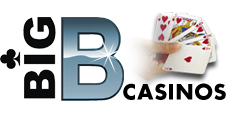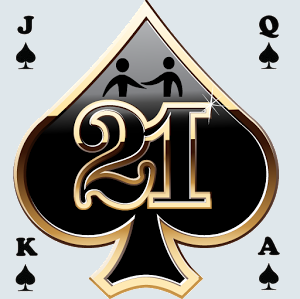Big B Casinos Blackjack Strategy Guide
In Blackjack each player at the table and the dealer are dealt two cards each, players play against the dealer not other players at the table. The object of the hand is to obtain a hand that comes closer to twenty-one without going over than the dealer does.
The best hand a player can get is a hand that values twenty-one in their first two cards (a Blackjack); which consists of an Ace and a card valued at ten. If you get a Blackjack then you are paid three chips for every two that you wagered unless the dealer has a blackjack too, then you push and your original bet is returned back to you. There are several things that you as the player decide throughout the game for instance you decide when to hit (get another card) and stand (take no more cards). You have this decision, the dealer has a set of rules of when he has to hit or has to stand. If you get a hand valued at closer to twenty-one than the dealer then you win that hand and you win the amount equal to what you bet in the first place. However, if you are playing and you go over twenty-one then you bust (lose the hand) and that hand of gambling is over. Players always have the advantage of flexible play in this game because they have options i.e., deciding when to hit, when to stand, when to split, and when to double down.
Card values must be learned before you enter a Blackjack game, the cards two through ten are counted at face value (the number printed on the card); all Face Cards are counted as ten and the Ace may be counted as either a one or an eleven. The suits of the cards are of no relevance in the game of blackjack. The Ace having two possible values sometimes confuses people so here is a rule of thumb, always count the Ace as an eleven until the eleven will put your hand over the twenty-one mark.
Talk of the Ace value goes right into the next point you should know about Blackjack; Hard Hands and Soft Hands. In short a Hard Hand is a hand that has no Ace in it; therefore its value is firm. A Soft Hand is a hand that has an Ace in it and can be counted either way. This gives you the player an advantage because you can never bust when hitting a soft hand.
To start the game a bet has to be made by the player. At the beginning of each game the player places his bet in the square on the table in front of them (or multiple squares if playing multiple hands). Now that it is time to deal the dealer deals his cards face down so you can’t tell what he has, then after you get your two cards the dealer will turn up one of his cards and keep the other one for his hole card. Only after you have played your hand through will the dealer turn up his other card and reveal his hand so a winner can be decided.
If the first two cards that are dealt to you are cards that are of the same numerical value you have the option to ‘split’ the pair and play them as two separate hands, keep in mind that you must bet the same on the split hand as you did on your first hand. The original hand is played out first, followed by the second hand. Any ace that is drawn to a split ten is not a blackjack, but the dealer will need a blackjack to beat your hand now valued at twenty-one. There is also the option to double down on a hand that consists of two cards; this is essentially doubling your original bet. When doubling down only one additional card can be received. Some online casinos restrict the double down option by not letting you to double down on a split hand, so seek the casinos with the least restrictive double down rules.
Insurance is an options offered by the dealer when their one face card up is an Ace, if you take this insurance you are betting that the dealer has a Blackjack and it costs half of your original bet and the payoff if you are right is two to one; basically if you win the insurance bet the dealer will pay you by leaving your original bet on the table.
Drawing and Standing
When to hit a hard hand |
||||||||||
Your Hand |
Dealers Up Card |
|||||||||
| X | 2 | 3 | 4 | 5 | 6 | 7 | 8 | 9 | 10 | A |
| 17 – 20 | X | X | X | X | X | X | X | X | X | X |
| 13 – 16 | X | X | X | X | X | H | H | H | H | H |
| 12 | H | H | X | X | X | H | H | H | H | H |
| 4 – 11 | H | H | H | H | H | H | H | H | H | H |
| H = Draw (hit). X = Don’t draw (stand). | ||||||||||
When to hit a soft hand |
||||||||||
Your Hand |
Dealers Up Card |
|||||||||
| X | 2 | 3 | 4 | 5 | 6 | 7 | 8 | 9 | 10 | A |
| 19 – 20 | X | X | X | X | X | X | X | X | X | X |
| 18 | X | X | X | X | X | X | X | H | H | H |
| 13 – 17 | H | H | H | H | H | H | H | H | H | H |
| H = Draw (hit). X = Don’t draw (stand). | ||||||||||
Doubling Down
When to Double Down on a Hard Hand |
||||||||||
Your Hand |
Dealers Up Card |
|||||||||
| X | 2 | 3 | 4 | 5 | 6 | 7 | 8 | 9 | 10 | A |
| 12 | X | X | X | X | X | X | X | X | X | X |
| 11 | D | D | D | D | D | D | D | D | D | X |
| 10 | D | D | D | D | D | D | D | D | X | X |
| 9 | X | D | D | D | D | X | X | X | X | X |
| 8 | X | X | X | X | X | X | X | X | X | X |
| D = Double Down | ||||||||||
Splitting
Your Hand |
Dealers Up Card |
|||||||||
| X | 2 | 3 | 4 | 5 | 6 | 7 | 8 | 9 | 10 | A |
| A,A | SP | SP | SP | SP | SP | SP | SP | SP | SP | SP |
| 10,10 | X | X | X | X | X | X | X | X | X | X |
| 9,9 | SP | SP | SP | SP | SP | X | SP | SP | X | X |
| 8,8 | SP | SP | SP | SP | SP | SP | SP | SP | SP | SP |
| 7,7 | SP | SP | SP | SP | SP | SP | X | X | X | X |
| 6,6 | *SP* | SP | SP | SP | SP | X | X | X | X | X |
| 5,5 | X | X | X | X | X | X | X | X | X | X |
| 4,4 | X | X | X | X | *SP* | *SP* | X | X | X | X |
| 3,3 | *SP* | *SP* | SP | SP | SP | SP | X | X | X | X |
| 2,2 | *SP* | *SP* | SP | SP | SP | SP | X | X | X | X |
| SP = always split. *SP* = split only when doubling down is allowed after splitting | ||||||||||

